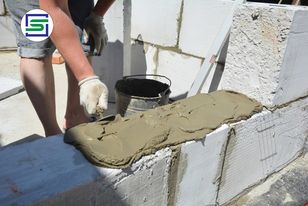How to reduce Cracks in AAC Block wall in Nepal

Some building experiences in
Nepal say that walls made up of AAC Block develop crack problem in site.
Construction of AAC Block actually started in Europe almost a hundred years ago
and it started becoming prevalent in Nepal since the last decade. Brick was the
building material used in wall in Nepal since ancient times. But AAC Block has
gained a lot of popularity because of its ease of handling and use, being
earthquake resistant, fire-resistant for a relatively longer time as compared
to brick walls. Some people, however, complaint that AAC Block wall crack
easily resulting in waste of material.
Here are a few suggestions or methods
we are providing you for making sure you don’t develop cracks in AAC Block
walls:
AAC Block Quality
As like Bricks, AAC Blocks also
has 3 kinds of Quality- Standard 1, Standard 2 and Standard 3. You must always prefer Standard 1 AAC Block in
order to minimize crack appearance. The above mentioned standard numbers are
based on shrinkage capacity. Standard 1 AAC Block has lowest shrinkage capacity
whereas standard 2 AAC Block has high shrinkage when blocks come in contact
with water.
Place the
AAC Blocks above ground
It’s the best when you place AAC Blocks above ground for storage. You must maintain at least 300mm board above ground level. Placing AAC Blocks in the ground will only help it absorb water which will later shrink down to form a crack in the AAC Block wall.

Use AAC
Block Joint Chemical instead of Cement Sand Mortar
People prefer to use cement sand
mortar instead of AAC Block Joint thinking that AAC Block Joint Chemical is
expensive. However, researches and our experience shows that AAC Block Joint
chemical price is almost as same as Cement Sand Mortar. Cement Sand Mortar has
water in it and water is soaked by AAC Blocks most of the time- resulting in a
weak bond. If you use a chemical, joints between the AAC Blocks in the walls
are stronger.
Height of
AAC Block Construction
AAC Block Construction can be
done for any height possible, but with structural aspects fulfilled. If you are
building a parapet wall with AAC Blocks, make sure that you are constructing it
only upto the height of 1200mm. When constructing internal and external walls,
you must give it a sill and lintel. The sill and lintel must at least be 4
inches in thickness and have two longitudinal rebar at least of size 10mm. Sill
and lintels always covers the full breadth of the wall.
Don’t Soak
AAC Block in Water
When a brick wall is to be laid,
IS:2212: 1991 says that the brick should be soaked for 24 hours in water before
laying it out with mortar. However, AAC Blocks should never be soaked inside
water. The matter of fact is AAC Blocks have high expansion and high shrinkage
as compared to Brick. After drying, the AAC Block will shrink resulting in
cracks.
No sill and lintel in AAC Block wall
Incase AAC Block walls are used
as interior walls, the practice is to not use a sill and lintel level. This
always results in a diagonal crack in case of earthquakes because there is no
sill and lintel beams. Sill and lintel always covers the full breadth of wall.
The portion of wall between sill and lintel, between lintel and beam and
between sill and floor level act as a block during earthquakes. The lesser
height of block doesn’t result in diagonal cracks.
Don’t use AAC Block Walls in Damp Areas
It has often been seen that walls
made up of AAC Blocks develop cracks when used in Damp Areas. It is only
because AAC Blocks soak more water and expand more than bricks. When dry, AAC
Block contract faster and crack is the result. If there is any compulsion to
use AAC Blocks in damp areas, you must use suitable waterproofs like bitumen
and damp proof course before laying wall above it. Often in the market, brick
walls are used in Damp areas because even if efflorescence happens in the
brick, it doesn’t prevent result in structural weakness of wall.
Connection between AAC Block walls and Concrete
Crack below beams is a common
problem often because of lack of construction ideas. To avoid horizontal crack
line just below beams, The blocks should not directly be touched with the
concrete beam. Cement sand mortar must be inserted and packed in between the
wall and concrete beam. In case of poor workmanship, chicken mesh must be placed
longitudinally between wall and beam and then plaster works should be carried
out in order to avoid horizontal cracks.